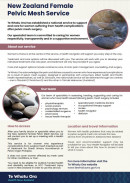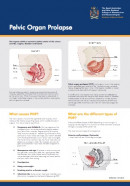Surgical mesh
Key points about surgical mesh
- The term surgical mesh refers to a permanent synthetic implant that is usually made from a non-absorbable polypropylene (plastic) material.
- There are 2 types of surgical mesh – partially absorbable or non-absorbable.
- The most common mesh used is non-absorbable mesh. This remains in your body indefinitely so should be considered a permanent implant.
- Most people who have mesh inserted, particularly for hernia repair, have no complications.
- Complications are rare and range from mild to very severe.
- If you notice any unexpected symptoms or complications from surgical mesh, see a doctor straight away.

- The term surgical mesh refers to a permanent synthetic implant that is usually made from a non-absorbable polypropylene (plastic) material.
- There are 2 types of surgical mesh – partially absorbable or non-absorbable. The most common mesh used is non-absorbable mesh. This remains in your body indefinitely so should be considered a permanent implant. If there are complications it may not be able to be removed.
- Surgical mesh is widely used for hernia repair and often in the treatment of stress urinary incontinence (SUI) and pelvic organ prolapse (POP), which includes bladder, uterine, vaginal, bowel and rectal prolapse.
- Most people who have mesh inserted, particularly for hernia repair, have no complications.
- Complications are rare and range from mild to very severe. However if they occur, they can have significant physical and psychological impacts and effects on your quality of life and mental wellbeing.
- To give informed consent, make sure you have had all the information, options and risks explained to you. This includes the possible benefits and risks of complications, as well as any alternative treatment options. Take time to consider your options and ensure you have enough information to make an informed decision.
- If you notice any unexpected symptoms or complications from surgical mesh, see a doctor straight away.
23 August 2023: Pause on the use of surgical mesh for stress urinary incontinence proceduresIn Aotearoa New Zealand a pause on the use of surgical mesh to treat stress urinary incontinence has been put in place by the Director-General of Health. The pause is for a limited time period while steps are put in place to ensure that any risk of harm associated with the procedure is as low as possible. If you are on the waiting list for stress urinary incontinence surgery using surgical mesh you will be contacted so that other ways to manage your condition can be discussed with you. The use of surgical mesh for other procedures will go ahead as usual. More information is available on the Ministry of Health's surgical mesh page.(external link) |
Surgical mesh is a medical device used to repair and provide support to parts of your body that have become weakened. Mesh is used to treat stress urinary incontinence, rectal/bowel, vaginal, uterine and bladder prolapse and for hernia repairs.
These medical device implants are made from synthetic plastic and are designed to be a permanent implant. It is important to note that these devices may or may not be able to be fully removed. This is something you should consider when deciding on which surgical procedure is the right option for you.
Hernias are an area in a layer of tissue that is weak or torn. Hernias don’t always have to be treated but they can cause pain and other complications. Surgery is the only cure for hernias. Using surgical mesh lowers the risk of recurrence compared to not using mesh. This is because if mesh isn’t used then the tension of the tissues is much higher which increases the risk of it reoccurring. Mesh repair takes the strain off the tissues and is a standard first-line surgical technique around the world for most hernia repairs, including New Zealand. There is only one non-mesh surgical technique that is almost as good as mesh repair called “Shouldice repair,” but it still creates tension. Shouldice repair is a very subspecialised area that is not available in many countries. There are no specialised Shouldice surgeons in New Zealand.
Pelvic organ prolapse is where the organs in the pelvis drop down from their usual position and bulge into the vagina. In most cases non-surgical treatments like pessaries are tried first. If surgery is needed, native tissue repair without mesh is the preferred method when doing transvaginal surgery (surgery through the vagina, compared to through the abdomen called transabdominal). This is because of the higher risks of complications with transvaginal mesh. However, there are situations where the benefit of surgical mesh for pelvic organ prolapse outweighs the potential risk. Your surgeon will explain the different surgical options to you.
Stress urinary incontinence is when there is leakage of urine with effort or exertion such as sneezing or coughing. Pelvic floor exercises, weight loss, avoiding constipation, stopping smoking, using a pessary, vaginal estrogen, and dietary changes are often effective. A minority of women still have bothersome symptoms after non-surgical treatment and may be offered surgery. There are several surgical procedures for the treatment of stress urinary incontinence. Each have their own risks, benefits, complications, and risks of failure. One common procedure is where a sling made from mesh is placed around the urethra (the tube that connects the bladder to the outside). This provides extra support to the urethra to stop it from leaking. It is proven to be highly effective. In New Zealand only urogynaecologists (a type of sub-specialist) are allowed to do this surgery.
For hernias, there is no increased risk of mesh versus non-mesh repair. For both categories the risk of complications is about 10%. The only difference is that the risk of recurrence is lower with mesh. The risks are otherwise the same and include chronic pain (5–10%), infection, and bleeding. There is no controversy regarding the use of mesh in hernia repair.
The controversy over the past few years has been for “transvaginal mesh” in pelvic prolapse surgery, not for hernia repair. There have been concerns about the safety of transvaginal mesh because of increased rates of complications, especially with some commercial mesh kits. Some countries, including New Zealand since 2017, have banned transvaginal (not transabdominal) mesh for prolapse surgery. Therefore it is unlikely you would be offered transvaginal mesh for prolapse surgery in New Zealand.
Transabdominal mesh is sometimes used in patients with apical prolapse (where the top of the vagina bulges downwards). This is with a procedure called abdominal sacro-colpopexy where mesh is used to support the top of the vagina with the other side stitched to the front of the sacrum bone. This is safer than transvaginal mesh. There is clear guidance for the use of mesh in gynaecologic surgery. Complications rates are below 5% and include incision problems, bleeding, blood clot, bladder injury, bowel injury, and erosion (0.5% for polypropylene).
Erosion can occur which is where mesh pushes against and into the surrounding tissue, nerves and organs. Erosion can occur years after surgery with the most common being erosion into the vagina. Further surgery may be needed to cover the mesh or partly remove it. More rarely, mesh can cause extrusion. This is where mesh pushes through or perforates surrounding tissue, nerves and organs.
There are other surgeries such as sacrospinous ligament suspension and uterosacral ligament suspension. The decision that goes into the type of surgery offered is complex and well outside the scope of this article. Please discuss the risks and benefits with your surgeon.
Each type of mesh procedure carries its own risks and benefits.
For hernia repair, surgery is the only effective treatment, and up to 70% of people with hernias will eventually have surgery due to symptoms. If your hernia symptoms are mild, you may be happy to live with it and wait and see if surgery is needed at a later stage.
For pelvic organ prolapse and stress urinary incontinence there are multiple effective non-surgical options, and so usually these should be tried before having surgery. Surgery is more effective than non-surgical options but carries risks. As part of the informed consent process, you need to be fully informed on what is involved in the procedure, the possible benefits and risks of complications, as well as any alternative treatment options (both surgical and non-surgical).
If you are considering surgical mesh to treat stress urinary incontinence you should receive a copy of this document from ACC to discuss with your surgeon and support your decision-making: Considering surgical mesh to treat stress urinary incontinence?(external link)
Take the time you need to read it carefully and ask someone to explain anything you don't understand. Also, discuss any concerns or questions you have with your surgeon.
You have the right to seek a second opinion if you are not satisfied with the information you receive or would like further advice on your treatment options.
- Do you have any written information that I can take away with me?
- Before signing the consent form on the day of the operation, will there be an opportunity to contact you with any questions I have about the operation?
- Can you explain all my possible options, including non-surgical treatment, surgery with mesh and surgery without mesh?
- Why is mesh being suggested for me and what are the benefits over non-mesh alternatives?
- What brand of mesh will be used?
- What results have your other patients had?
- How many mesh operations have you performed using this particular mesh?
- How many removals of mesh have you undertaken?
- How many mesh-related complications have you come across?
- What will my follow-up care be like after the operation?
- What side effects can I expect after surgery and what side effects should I report to you?
- What happens if I experience complications or unusual symptoms in years to come?
- What are the risks associated with using this mesh product?
- If there is a complication will you be able to completely remove the mesh device?
- What happens if this surgery does not correct my problem?
If you experience any of the following symptoms after you have had surgical mesh implanted, contact your doctor immediately:
- pain (at the site of the mesh implant, including vaginal, groin, pelvic, referred pain down leg and back pain)
- urinary tract infection
- infection
- vaginal discharge
- difficulty urinating (peeing)
- excessive vaginal or urinary bleeding (note this can be normal)
- pain during sexual intercourse
- painful sex experienced by the partner when they feel the mesh during sexual intercourse.
If you have implanted surgical mesh and it causes pain or infection, or if you have any concerns, contact your healthcare provider. Depending on the type of surgery you had, you may be eligible for the new nationwide New Zealand Female Pelvic Mesh Service (see the section below).
If you're not eligible, your healthcare provider can advise you on what to do and will be able to arrange a referral if required.
You are urged to report any adverse events experienced in relation to the use of surgical mesh to Medsafe(external link). You can use this form to report your experience: Adverse Event Report (Consumers)(external link).
You also have rights under the Code of Health & Disability Consumers' Rights. If you consider these have been breached, you can make a complaint.
A new service has been set up to support women (defined as people born with female pelvic organs – vagina, uterus and ovaries) who've had complications from having surgical mesh put into their bodies during the following types of surgery:
- All pelvic mesh inserted for pelvic organ prolapse (POP)
- All pelvic mesh inserted for stress urinary incontinence (SUI)
- Pelvic mesh inserted for rectal prolapse (rectopexy) if another type of pelvic mesh for either POP or SUI was also inserted. If only rectopexy mesh was inserted you will be referred to a colorectal specialist instead.
- Non-mesh slings for SUI if complications have occurred.
Note: the service doesn't cover women affected by surgical mesh used for hernia repair in the pelvic region, or men.
You can access the FMPS if you are eligible for publicly funded health and disability services in New Zealand OR if your GP or specialist believe your mesh complications may be covered by ACC as Treatment Injury ACC.
The service is available nationwide
The FPMS is available to eligible people living anywhere in Aotearoa New Zealand but is based in Auckland and Christchurch. Phone or video consultations will be available for people living outside these 2 regions and if you need to travel for an appointment or assessment some expenses may be covered for you and a support person.
Access to the service is through your healthcare provider who will organise a meeting with an FPMS health navigator (one for Christchurch and one for Auckland) who will support and guide you through the process. Different types of health professionals are part of the service to enable an individual treatment and care plan to be developed with you. Treatment will only be provided if you agree.
In 2019, the Ministry of Health led a process to hear directly from New Zealanders affected by surgical mesh. The stories shared through this process were independently analysed by a team from the Diana Unwin Chair in Restorative Justice, Victoria University of Wellington and resulted in the report Hearing and responding to the stories of survivors of surgical mesh(external link), released in December 2019. The Ministry has said it's committed to progressing the actions included in the report and working with other agencies to support those who have been affected and to minimise future harm.
Accident Compensation Corporation (ACC) review of declined surgical mesh claims
From October 2020 onwards, ACC is offering to reassess declined surgical mesh injury claims. This was one of the actions agreed to in the report. If you have had a claim for a surgical mesh injury declined, you can ask ACC to reassess it. This will apply to cover decisions made before 28 October 2020.
To have your claim reassessed, you can contact ACC by:
- calling 0800 735 566 and choosing option 5
- emailing [email protected]
- visiting your GP and taking information with you from this ACC page(external link) or saving the page on your phone
- discussing this with your specialist doctor if you have one at an upcoming appointment.
Read more about reassessing declined surgical mesh claims(external link) ACC, NZ, 2020
Hearing and responding to the stories of survivors of surgical mesh(external link) Ministry of Health, NZ, 2019
New Zealand Female Surgical Mesh Service flyer [PDF, 507 KB] Te Whatu Ora, NZ, 2023
Apps
Pelvic floor exercise apps
Pain management apps
References
- Surgical mesh(external link) Ministry of Health, NZ
- Mesh down under(external link) A consumer organisation dedicated to offering support and information to New Zealanders affected by the use of surgical mesh
Pause on use of surgical mesh
A time limited pause on the use of surgical mesh for stress urinary incontinence has been out in place in Aotearoa New Zealand by he Director-General of Health. It's effective from 23 August 2023.
Surgical Mesh statement from Director-General of Health(external link) Ministry of Health, NZ, 2024
The pause will remain in place until the following 4 conditions have been met, which aim to minimise harm associated with the procedure:
- Mandatory credentialing of surgeons who can perform the procedure.
- Establishment of a registry for female pelvic floor procedures including mesh.
- Use of a structured informed consent process using a patient decision aid.
- Patient case discussions at multidisciplinary team meetings.
Hearing and responding to the stories of survivors of surgical mesh(external link) Ngā kōrero a ngā mōrehu – he urupare Report for the Ministry of Health, Victoria University of Wellington, NZ, 2019
The New Zealand Female Pelvic Mesh Service(external link) Health New Zealand | Te Whatu Ora
Apps
Credits: Healthify editorial team. Healthify is brought to you by Health Navigator Charitable Trust.
Reviewed by: Dr Jeremy Steinberg, FRNZCGP
Last reviewed:
Page last updated:







